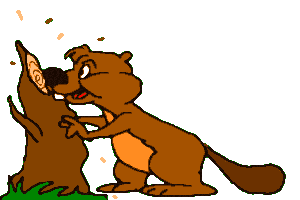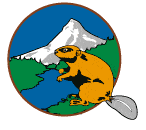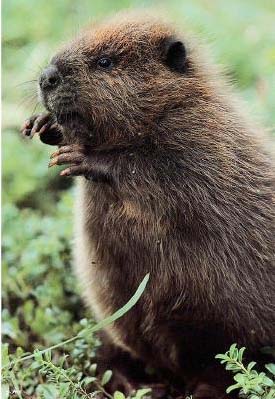|
|
Canku Ota |
|
|
(Many Paths) |
||
|
An Online Newsletter Celebrating Native America |
||
|
June 30, 2001 - Issue 39 |
||
|
|
||
|
The Beaver and The Flea |
||
|
Kwakiutl Legend |
 It
was very dry weather. A beaver was working, while a flea watched him. “What are you making?” asked the flea. “I'm
making a dam,” replied the beaver. “There's no rain, so I'm going to dam this little stream and make a pond.” It
was very dry weather. A beaver was working, while a flea watched him. “What are you making?” asked the flea. “I'm
making a dam,” replied the beaver. “There's no rain, so I'm going to dam this little stream and make a pond.” He finished cutting down an alder sapling with his big front teeth. “Why do you ask?” he inquired. “Oh, I just wanted to know. I've never seen a dam before,” answered the flea. “I wonder when it's going to rain?” the beaver mused. “Nobody seems to know,” he added, “so I'm going to make a house in the pond. When it does rain, I will have a home to go to.” “It never rains here,” the flea informed him. “It will some day,” Beaver said. “Then, I should look for shelter too,” stated the flea, “because, if it should happen to rain, I don't want to drown.”  “Why don't you make a shelter like mine?” asked Beaver. “Do you think I have time?” queried the flea. “Sure,” said Beaver. “There's no sign of rain yet—no clouds or anything. If you can't get your shelter finished in time, you can come into my hair and have shelter there.” It was not long before the rain came. The Beaver said to the flea, “It's too late to finish your shelter now. Come on, jump into my hair and I'll take you into my house.”  “Okay,” said the flea, “here I come,” and he jumped into the beaver's fur. When Beaver got inside his shelter, he started to itch. “You can come out of my fur now,” he said to the flea, but flea did not come out. He liked it in the beaver's fur. Beaver shook and scratched, and shook some more. Finally the little flea fell out, but the beaver did not see where flea went. |
|
Print and Color Your Own Beaver: |
 Beaver are more than intriguing animals with flat tails and lustrous fur. American Indians called
the beaver the "sacred center" of the land because they create rich habitats for other mammals, fish,
turtles, frogs, birds and ducks. Beaver are more than intriguing animals with flat tails and lustrous fur. American Indians called
the beaver the "sacred center" of the land because they create rich habitats for other mammals, fish,
turtles, frogs, birds and ducks. The North American beaver, Castor canadensis, is a large, web-footed, semi-aquatic rodent with brown fur and a wide, flat, dark tail. The tail acts as a rudder while swimming, as a prop for standing upright, as a lever when dragging tree logs, and as a noise maker for producing a warning signal when it is slapped on the water. The fingers have long claws, and the legs have webbed feet and claws. The beaver has a large, wide, head. It has sharp, renewable, self-sharpening, enameled teeth that can cut through wood and fell a tree. Beavers' ability to change the landscape is second only to humans. But that is just one reason why we find the flat-tailed species fascinating. Adults may weigh over 40 pounds, and beaver mate for life during their third year. Both parents care for the kits (usually one to four) that are born in the spring. The young usually stay with their parents for two years, and yearlings act as babysitters for the new litter. While some beaver behavior is instinctive, they also learn by imitation and from experience. Wildlife rehabilitators find beavers to be gentle, reasoning beings who enjoy practical jokes. An Indian word for "beaver-like" also means "affable." Once weaned, their favorite foods include water lily tubers, clover and the leaves and the green bark (cambium) from poplar and other fast-growing trees. Tree cutting is part of nature's cycle and beaver pruning stimulates willows to regrow bushier than ever next spring. After eating, beaver often use the peeled sticks to build a teepee-like lodge (house) on the shore and/or a dam.  By damming streams, beaver raise the water level to surround their lodge
with a protective moat, and also create the deep water needed for winter food storage in northern climes. Their
lodges, made of tangled sticks and caked mud, offer protection that even black bears have difficulty in breaking
through. While other wildlife endure wintertime cold and hunger, beaver stay warm in their lodges with an underwater
food cache nearby. By damming streams, beaver raise the water level to surround their lodge
with a protective moat, and also create the deep water needed for winter food storage in northern climes. Their
lodges, made of tangled sticks and caked mud, offer protection that even black bears have difficulty in breaking
through. While other wildlife endure wintertime cold and hunger, beaver stay warm in their lodges with an underwater
food cache nearby. Beavers have a well-developed social hierarchy in which the family is the basic unit, and the female the central figure in each family. A beaver colony, can consist of six or more including parents, yearlings and kits, yet they peacefully coexist in a lodge with underwater access to the iced-up pond for four months or more. Because they breed once a year, require large streamside habitats, and two-year-olds leave home each spring to find their own territories, beaver rarely overpopulate. Small kits have many predators including hawks, owls, bobcat, coyote and dogs. Bear, wolves, dogs and coyote can also take adults. |
|
The Beaver |
|
Beaver |
|
|
||
|
|
||
| Canku Ota is a free Newsletter celebrating Native America, its traditions and accomplishments . We do not provide subscriber or visitor names to anyone. Some articles presented in Canku Ota may contain copyright material. We have received appropriate permissions for republishing any articles. Material appearing here is distributed without profit or monetary gain to those who have expressed an interest. This is in accordance with Title 17 U.S.C. section 107. | ||
|
Canku Ota is a copyright © 2000, 2001 of Vicki Lockard and Paul Barry. |
||
|
|
|
|
|
The "Canku Ota - A Newsletter Celebrating Native America" web site and its design is the |
||
|
Copyright © 1999, 2000, 2001 of Paul C. Barry. |
||
|
All Rights Reserved. |
